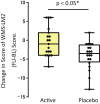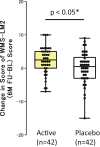Effect of Anserine/Carnosine Supplementation on Verbal Episodic Memory in Elderly People
- PMID: 26682691
- PMCID: PMC4927867
- DOI: 10.3233/JAD-150767
Effect of Anserine/Carnosine Supplementation on Verbal Episodic Memory in Elderly People
Abstract
Our goal in this study was to determine whether or not anserine/carnosine supplementation (ACS) is capable of preserving cognitive function of elderly people. In a double-blind randomized controlled trial, volunteers were randomly assigned to an ACS or placebo group at a 1:1 ratio. The ACS group took 1.0 g of an anserine/carnosine (3:1) formula daily for 3 months. Participants were evaluated by psychological tests before and after the 3-month supplementation period. Thirty-nine healthy elderly volunteers (60-78 years old) completed the follow-up tests. Among the tests, delayed recall verbal memory assessed by the Wechsler Memory Scale-Logical Memory showed significant preservation in the ACS group, compared to the placebo group (p = 0.0128). Blood analysis revealed a decreased secretion of inflammatory cytokines, including CCL-2 and IL-8, in the ACS group. MRI analysis using arterial spin labeling showed a suppression in the age-related decline in brain blood flow in the posterior cingulate cortex area in the ACS group, compared to the placebo group (p = 0.0248). In another randomized controlled trial, delayed recall verbal memory showed significant preservation in the ACS group, compared to the placebo group (p = 0.0202). These results collectively suggest that ACS may preserve verbal episodic memory and brain perfusion in elderly people, although further study is needed.
Keywords: Alzheimer’s disease; anserine and carnosine; cognitive function; dementia; elderly people; inflammatory cytokine; perfusion MRI; randomized controlled trial; verbal memory.
Figures







References
-
- Baumgart M, Snyder HM, Carrillo MC, Fazio S, Kim H, Johns H (2015) Summary of the evidence on modifiable risk factors for cognitive decline and dementia: A population-based perspective. Alzheimers Dement 11, 718–726. - PubMed
-
- Lindenberger U (2014) Human cognitive aging: Corriger la fortune?. Science 346, 572–578. - PubMed
-
- Gutchess A (2014) Plasticity of the aging brain: New directions in cognitive neuroscience. Science 346, 579–582. - PubMed
-
- Cooper JK (2014) Nutrition and the brain: What advice should we give?. Neurobiol Aging (Suppl 2) 35, S79–S83. - PubMed
-
- Farías GA, Guzmán-Martínez L, Delgado C, Maccioni RB (2014) Nutraceuticals: A novel concept in prevention and treatment of Alzheimer’s disease and related disorders. J Alzheimers Dis 42, 357–367. - PubMed
Publication types
MeSH terms
Substances
LinkOut - more resources
Full Text Sources
Medical
Molecular Biology Databases

